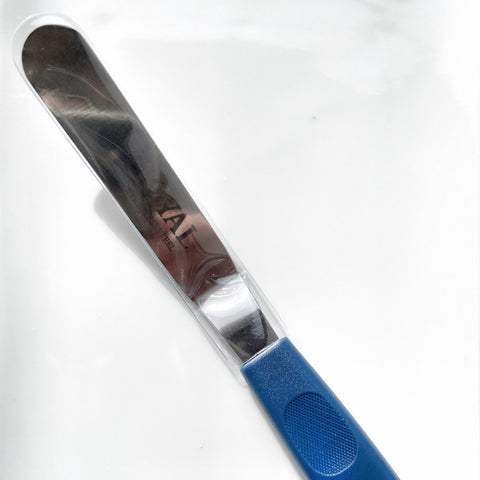Ever wondered how the professionals manage that perfectly smooth crisp edged icing on their cakes?
There's not some hidden secret to how they do this, and just like any profession, it's about having the right tools, know how and patience to get the finished result.
In this article we are going to discuss the cake scraper, a tool you need to achieve a smooth finish on your icing.
A good point to note is that in the cake decorating space, one size does not fit all, there are a range of tools on the market that will do the job, but it comes down to preference on what tool suits you best.
Before we get to the nitty gritty of the cake scraper, it's worth first discussing a tool that (although not necessary) will help you spread icing around your cake like a boss, and that's the angled cake spatula.

Our advice to beginners is that you don't need this (and that's true! a plain old butter knife will do the trick), but it's a great tool to have on hand for achieving that semi smooth finish before proceeding to the final stages of icing your cake.
If you plan to decorate more cakes in future we highly recommend getting one of these to add to your decorating tools. They can also be used for spreading creams, curds and other fillings.
They come in different sizes, so you'll want to get a size that suits you, but starting small is our advice until you feel confident using a larger one.
With that said, let's now discuss the cake scraper (also called a cake smoother or comb), the tool that achieves smooth icing and sharp edges. Scrapers come in different sizes, shapes and even materials. 
You're probably thinking, ugh!, sounds all too hard and you're probably right.
Finding the tool that suits you best is a matter of trial and error and when you're a beginner it's even harder to know what you should buy.
Luckily, we have loads of experience using all sorts of cake scrapers and we've broken it down into the main types, along with the pro's and con's of each to consider.
Cake Scrapers
Metal
Most expensive and hardest to use, but gives a really smooth finish time and time again. Cleaning the scraper between strokes takes longer as it's not easy to scrape the buttercream on the side of a bowl. Metal scrapers are also much heavier and rigid so it takes a bit of practice to master it. These scrapers will last a very long time and are unlikely to damage.
Acrylic
This material also works well, but again is timely to clean off the icing between strokes, is often quite thick making it rigid and bulky to handle. If damaged on the edges, these scrapers will not be good for smoothing icing.
Plastic
The cheapest and easiest to use, especially great for beginners learning how to smooth icing. Plastic is flexible allowing you to scrape excess icing off into the icing bowl and its lightweight which means its much easier to handle.
So what do the professionals use?
Metal and acrylic scrapers tend to be the most widely used, however, if you're a beginner then we highly recommend using a plastic cake scraper to start with. This is the tool that we provide in our cake kits to get you started and believe it's the best for all levels.
No matter the material you choose, the most important thing to ensure is that your scraper is at least as tall as your cake, so that you can reach the entire surface when smoothing.
So to sum it all up, the angled cake spatula is awesome for spreading icing and is a great little tool to have in your decorating kit. To achieve smooth icing on your cake you're going to want to invest in a cake scraper and if you're a beginner, we recommend starting with a plastic one until you get the hang of the technique.
Happy caking!

